Atlantic Salmon | |
| As Published In The 2009 Rotary Fishing Tournament Tabloid By Captain Mickey Maynard 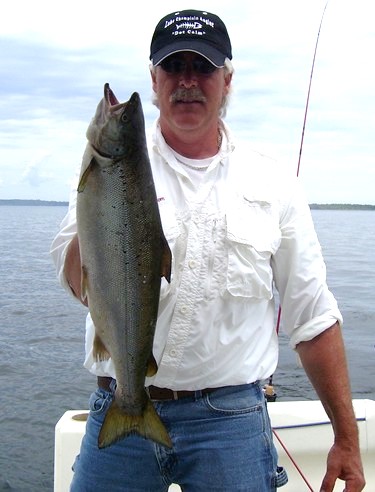 Captain Mickey Maynard hoists an Atlantic salmon caught by a client in June 2009. Salmo Salar, The King Of Gamefish | |
Many Lake Champlain fishermen consider the Atlantic salmon to be the most powerful, exciting and challenging specie to inhabit the watershed. They strike with vengeance and when hooked make lightening fast runs, often breaking water, soaring straight up acrobatically, or tail walking across the surface like a billfish. In fact, Atlantic salmon are known scientifically as Salmo Salar, the binomial Latin title translated “Salmon the Leaper”. This Latin term was assigned to the specie in 1758 by a zoologist and taxonomist named Carolus Linnaeus. Today most anglers know Atlantic salmon as the “King” of game fish. While there are six species of Pacific salmon, there is only one Atlantic salmon. The Atlantic salmon is an anadromous fish, typically spending 2-3 years in freshwater rivers, migrating to the ocean where it also spends 2-3 years, and then in autumn returning to its river of origin to spawn. In Lake Champlain Vermont and New York fisheries managers stock the landlocked version of this fish. To these landlocked salmon, Lake Champlain is their ocean. As part of their anadromous migratory life cycle these seasoned fish have spent at least one summer in the lake and will return to the river, often in sync with a significant fall rain. In spring the salmon also run up Lake Champlain’s tributaries, but it’s the warmer runoff and schools of baitfish that trigger this migration. The young adult salmon that return after only one year in the lake are called grilse. Grilse salmon in Lake Champlain average from 16 to 19 inches and are usually less than two pounds in weight. These are the fish that are most often caught by anglers. Mature spawning salmon are more rare and average from 3 to 8 pounds. In fall they move to the upper reaches of the tributary in pairs, then locate and hold on a spawning nest known as a redd. Unlike Pacific salmon, most Atlantic salmon will return to the lake and are capable of spawning more than once. In autumn Atlantic salmon will be noticeably darker than those entering the river during their false run in spring. The spawning males will usually have a pronounced hooked jaw called a kype. Their spotted gill plates will often have beautiful dark purple and blue hues. A female salmon weighing about eight pounds is capable of laying approximately 8,000 eggs, but the odds are against the brood. In the wild fewer than three of these many eggs will grow to be mature spawning progeny. | |
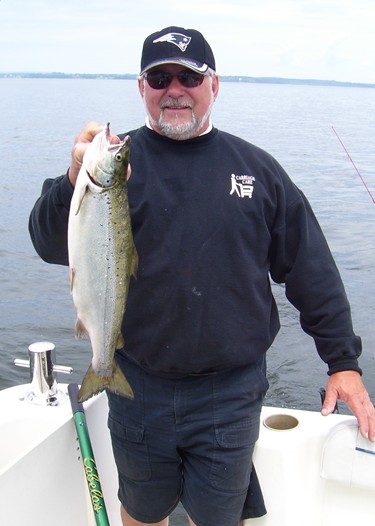 New Hampshire charter client Mike boasts a nice salmon in the four-pound class caught in Malletts Bay. Atlantic Salmon History | |
|
Sea run Atlantic salmon migration occurred historically in nearly every coastal tributary north of the Hudson River, but by the mid 19th Century North American stocks were severely depleted. Water quality degradation, overharvesting and damming of tributaries for power have been cited as significant causes for the demise of the once bountiful fish. Atlantic salmon were also native to Lake Champlain and very plentiful. On a 1776 map of the lake a salmon fishery is noted at the mouth of the Great Chazy River. Historical records show fish up to 20 pounds were once found here in abundance. In earlier days farmers gathered salmon along the lake’s tributaries by the wagon load, in part for food, but most often to be used as fertilizer. In recent years researchers have been trying to determine whether the historic Lake Champlain stocks were landlocked or ocean strains. | |
|
Adirondack Fish Culture Station | |
|
The specialized Adirondack Fish Culture Station in the tiny hamlet of Lake Clear near Upper Saranac Lake is one of twelve New York State hatcheries and is the only one solely devoted to raising Atlantic salmon. Around the second week in November of each year culturist and manager Ed Grant and his employees focus their attention and skills on the collection of Atlantic salmon eggs and milt from protected brood stock residing in hatchery holding tanks and in nearby Little Clear Pond. The harvesting of eggs and their fertilization is the first step in the process of raising and stocking landlocked Atlantic salmon. The processed eggs are then carefully incubated in clean flowing water for approximately 70 days until small salmon known as sack fry emerge. Once the egg sack is absorbed the tiny salmon fry are moved to shallow flowing tanks and fed appropriately sized food until they are ready for stocking. | |
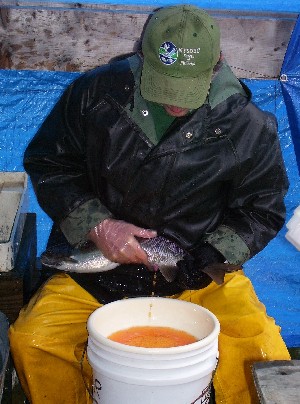 An Adirondack Fish Culture Station employee gently strips a mature Atlantic salmon of her eggs | |
|
Lake Champlain’s salmon fry get special treatment. Biologists believe the Champlain fry should grow from more natural food sources in the lake’s rivers so that they will be more likely to “imprint”, a term that refers to the returning of the salmon to its place of origin or stocking location. These fry are processed in colder water to initially slow their growth so that they begin to feed more heavily in May, just after being placed in the lake’s tributaries. The White River National Hatchery in Bethel, Vermont, operated by the US Fish and Wildlife Service, also obtains some eggs from the Adirondack hatchery for studies. Salmon from their studies are also placed in Lake Champlain to supplement fish stocked by Vermont and New York State programs. Each year the Adirondack hatchery aids in the production and stocking of over 650,000 fish in more than 50 public waters throughout New York. Of the total salmon stocked by the Adirondack Fish Culture Station each year, about 325,000 are fry or newly hatched young. About 25,000 are fingerlings, 3 to 5 inches long, and approximately 300,000 are yearlings. New York's predominant landlocked Atlantic salmon strain has been the Lake Clear strain. This strain was derived from three particular heritage strains, which include the Swedish Gull Spang strain as well as the West Grand Lake and Sebago Lake strains from the state of Maine. In recent years the Adirondack Fish Culture Station has increased its numbers of wild Sebago Lake salmon. Studies by both Vermont and New York agencies indicate that the Sebago Lake salmon is a better tributary spawning strain and will be more likely to imprint. The Adirondack Fish Culture Station also provides an educational resource for students of all levels throughout the region. Each year the hatchery’s November assisted spawning event is witnessed by groups of elementary, middle school and high school aged students who tour the Fish Culture Station escorted by members of the Lake Champlain and Tri-Lakes Chapters of Trout Unlimited. These TU chapters sponsor “Salmon in the Classroom” science projects in a number of North Country schools. Along with teachers, they educate students about the life cycle of Atlantic salmon as well as the importance of water quality and a well-balanced environment. Each class is introduced to the breeding process at the hatchery and then they raise their own fish from eggs in aquariums in their classrooms throughout the winter. In spring the students stock their young fish in rivers and streams across the region. The experience builds stewardship skills and an appreciation for the aquatic environment. | |
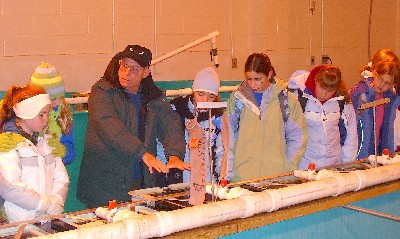 Lake Champlain Chapter of Trout Unlimited representative Bill Wellman shows touring students how water flows over incubation banks in the hatchery | |
|
Threats, Trials and Tribulations | |
|
Lake managers and biologists are challenged by modern-day threats to the Lake Champlain Atlantic salmon fishery. The sea lamprey in Lake Champlain has been decimating coldwater species since stocking programs began. A cooperative effort by the New York State Department of Environmental Conservation, Vermont Fish and Wildlife and the US Fish and Wildlife to control the parasite showed brief promise but populations rebounded and lamprey-wounding rates soared to unacceptable heights. In 2008 increased efforts by state agencies lead to a decline in wounding rates and renewed optimism for Lake Champlain’s fishery. As lamprey control becomes more methodical and timely Lake Champlain’s salmon stocks should rebound. The recent advent of alewives in Lake Champlain will present new challenges to management officials. When Atlantic salmon or lake trout forage primarily on an alewife diet the chances for self-sustaining populations are severely diminished. The alewife diet causes a thiamine deficiency in both lake trout and Atlantic salmon. Another sad fact about alewives is their tendency to die-off in large numbers. This baitfish is sensitive to sudden temperature changes and other stress factors like spawning. While trout and salmon might feed heavily on them and grow significantly when numbers are booming, the bust population tendencies can lead to a severely reduced forage base in the lake during other periods. According to biologists this already happened last year in the Inland Sea. | |
|
Atlantic Salmon Fishing Methods and Seasons | |
|
During the spring run fish typically remain in the rivers from early April through late May and are often targeted by wading fly fishermen using streamers or nymphs. Spin fishermen can also wade or cast various lures from the banks. Krocodile, Little Cleo, Thompson Buoyant casting spoons, or small # 6 Rapala stick baits are good lure choices. Some rivers like the AuSable and Winooski have lengthy stretches where trolling with small vessels for Atlantic salmon is a good option. By late May the Atlantic salmon are leaving the tributaries and returning to the broad lake. This phase is timed well for Rotary International Fishing Derby enthusiasts. Salmon anglers trolling the broad lake with downriggers using small spoons or streamers do particularly well in the derby. One spoon, the Tamiron Honey Bee, is a personal favorite and a preferred lure of many successful anglers who target Atlantic salmon. Other good choices for broad lake trolling are Needlefish and Mooselook spoons. These spoons are best trolled at a relatively quick pace. Atlantic salmon are a bit harder to find in the summer months, but they can be caught using downriggers and a little patience if an angler is willing to experiment in deeper levels of the water column. The deep waters of the Inland Sea and the mid-lake south of the Four Brothers Islands and Willsboro Point have traditionally been good areas to target salmon in mid summer months. The obvious opportunity comes as salmon return to the rivers to spawn in early September. During years when the fishery is in good health and water levels are favorable good numbers of mature fish will enter the tributaries and remain targetable for several weeks. Be advised that special regulations are in effect in fall on stretches of some rivers to protect spawning fish. Atlantic salmon fishing really heats up again on the broad lake in the late fall as surface temperatures drop and winter approaches. Willsboro Point to Split Rock on the New York side or areas around Sloop Island on the Vermont side offer some of the lakes best Atlantic salmon fishing during October, November and even early December. | |
|
Size Matters | |
|
Atlantic Salmon can grow very large in ocean stocks. The biggest fish on record was caught in a net off Scotland and weighed in at 103 pounds. Another large specimen, an 83 pounder, was netted in Ireland in 1882. A fish of well over 64 pounds was caught on rod and reel by a female angler in the Tay River in Scotland. The North American rod and reel record is 55 pounds, caught in 1939 on the Grand Casacpedia River in Quebec. An Atlantic Salmon weighing nearly 25 pounds was caught in Lake Ontario in 1997. The modern record for an Atlantic Salmon in Lake Champlain is a 12 pound 10 ounce fish caught in Vermont waters in 1994 by Brian Latulippe. | |
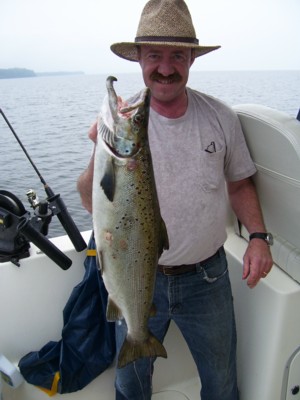 Claude Bouchard shows off a seven pound trophy male Atlantic salmon caught on a Tamiron Honey Bee spoon just south of Willsboro Point while on a mid-July, 2008 birthday fishing charter with the author | |
|
Today Lake Champlain’s Atlantic salmon stocks are a symbol of pristine, reclaimed waters that once ran wild with bountiful stocks of large native fish. It only takes one battle with a trophy Atlantic salmon for a Lake Champlain angler to be transported back to that earlier place and time. | |
|
We have Tamiron Honey Bee spoons for sale! Call or email Captain Mickey Maynard at the contact information on the home page. He'll hook you up and tell you how to use these productive Atlantic salmon lures.       Back to the main page | |